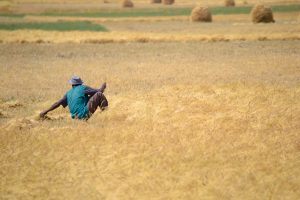It wasn’t well publicized, but in November 2023, in the second Forum on China-Africa Agricultural Cooperation, China committed to a target with Africa that no other development partner has. China committed to “promote trade value in agricultural products to more than US$20 billion within the next decade.”
The target is part of China’s broader strategy to enhance economic ties with Africa, including commitments made in 2021 during the much broader and high-level Eighth Forum on China-Africa Cooperation (FOCAC). Such targets include total trade between Africa and China reaching $300 billion by 2024 and imports from Africa to China reaching a total value of $300 billion over three years.
In this context, $20 billion sounds fairly small, yet it is ambitious. Africa’s agricultural trade with China was worth just $9 billion in 2023, representing only 3 percent of China’s total agricultural imports. So achieving the goal would require more than doubling agricultural exports in just six short years. However, this has been done before.
According to data from China’s Ministry of Agriculture, between 2000-2018, agricultural trade grew by 965 percent, from $650 million to $6.92 billion. Between 2018-2013, trade grew by 35 percent from $6.92 billion to $9.35 billion. To reach the $20 billion target by 2030, trade will need to grow by 114 percent between 2023-2030, making the target ambitious but not unprecedented.
Furthermore, since FOCAC 8, China has implemented key initiatives to boost agricultural trade with Africa, which will help.
First, the “Green Lanes” initiative was introduced to ease African agricultural imports through expedited inspection, quarantine procedures, and new sanitary and phytosanitary (SPS) agreements. Sixteen new African agricultural products from 11 countries have benefited from this streamlined access to China’s market since FOCAC 8, compared to 11 agricultural products from six countries between 1998 and 2021.
Second, China reduced tariffs on certain countries and products. By the end of 2023, 27 African countries with least-developed status had zero-tariff treatment on 98 percent of their exports to China.
Third, China committed to providing $10 billion in trade financing for African exports. While little has been publicized on which institutions are delivering this and where, certainly some African organizations have been involved. For instance, in August 2023, China Development Bank and the African Export-Import Bank signed a $400 million loan facility to support African SMEs engaged in intra-Africa trade and productive sectors, aligning with initiatives like the African Continental Free Trade Area (AfCFTA).
Fourth, and last but not least, the 2022 and 2023 China-Africa Economic and Trade Expos (CAETE) in Changsha and Nairobi, respectively, also promoted several African agricultural products alongside other Chinese government-sponsored livestreams and promotional events in 2022.
However, as discussed in a recent China-Africa trade dialogue in Beijing, co-organized by the African Union and Development Reimagined, despite these advancements, two fairly binding constraints remain on progress and, therefore, on the $20 billion target.
First, the lack of direct engagement of African SMEs and organizations in the FOCAC initiatives is a challenge, given African countries’ diversity and the importance of local knowledge of farming techniques, agricultural products, as well as markets. Running trade promotion schemes that are far removed from African stakeholders is unsustainable.
Second, underdeveloped value chains, insufficient mechanization, and a heavy reliance on unpredictable rainfall continue to hinder agricultural productivity in Africa, and this will only become more challenging with climate change.
So, what needs to happen now to make the $20 billion target by 2030 a reality? Several steps are essential, and with less than 65 days until the ninth Forum on China-Africa Cooperation in Beijing this September, these steps could form the basis of further, comprehensive, and strategic updates to China-Africa agricultural policy.
First, scaled-up direct and concessional lending for African agricultural infrastructure, including irrigation, post-harvest facilities, and transport, is needed to reduce losses and enhance productivity.
Second, continuing to accelerate but also expanding the Green Lanes initiative to focus on value-added and finished African agricultural products will help these products enter and compete in the Chinese market.
Third, recognizing and protecting African Geographical Indications (GIs) like Rooibos tea can elevate their market value in China, similar to European products like French champagne and Italian prosciutto.
Fourth, providing cheaper equity and debt for Chinese private sector investment in Africa’s agro-processing sector – especially through joint ventures, as was practiced in China – is crucial to building local capacity for producing competitive, value-added products.
Fifth, a partnership between Chinese banks and African banks to reach African SMEs is well overdue. A fund can be created to promote technological innovation, agricultural machinery, and other targeted support for small- and medium-scale farmers and agro-entrepreneurs.
Sixth, leveraging Chinese e-commerce platforms to boost sales of branded African products can significantly enhance market penetration.
Seventh and finally, further aligning China-Africa agricultural trade cooperation with AfCFTA through expanding duty-free access – especially for value-added products – to the entire continent will enhance regional integration and competitiveness.
In conclusion, achieving the $20 billion target by 2030 requires more than doubling the current $9 billion in agricultural exports from Africa to China. This might seem ambitious, indeed – no other development partner has a goal like this with Africa – but it is attainable with strategic efforts. If FOCAC 9 can be the launchpad for the supportive actions needed for it, China and Africa may well be able not just to reach but also surpass the goal.

































